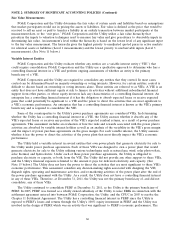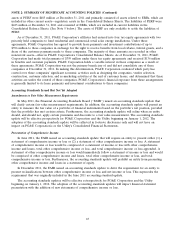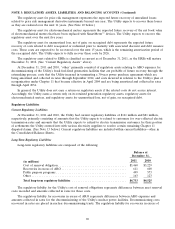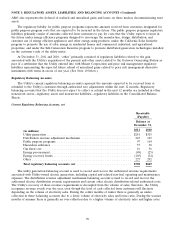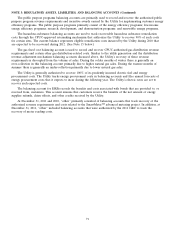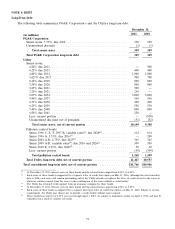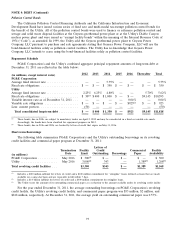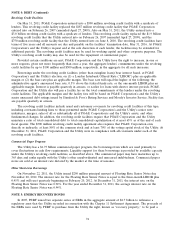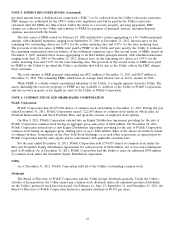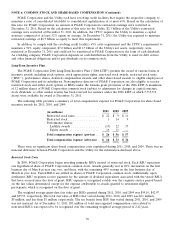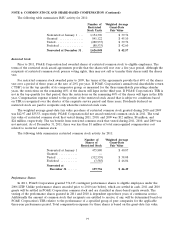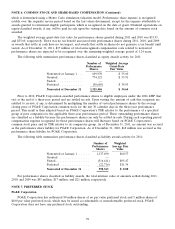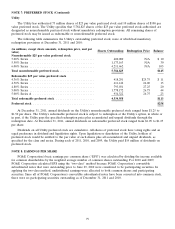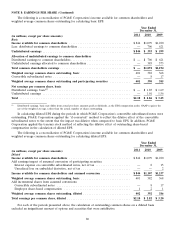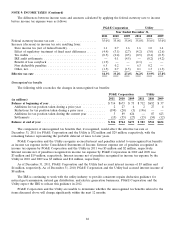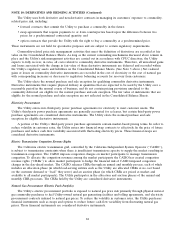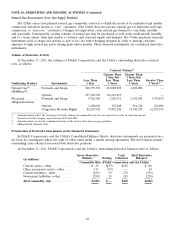PG&E 2011 Annual Report Download - page 80
Download and view the complete annual report
Please find page 80 of the 2011 PG&E annual report below. You can navigate through the pages in the report by either clicking on the pages listed below, or by using the keyword search tool below to find specific information within the annual report.
NOTE 6: COMMON STOCK AND SHARE-BASED COMPENSATION (Continued)
PG&E Corporation and the Utility each have revolving credit facilities that require the respective company to
maintain a ratio of consolidated total debt to consolidated capitalization of at most 65%. Based on the calculation of
this ratio for PG&E Corporation, no amount of PG&E Corporation’s reinvested earnings were restricted at
December 31, 2011. Based on the calculation of this ratio for the Utility, $2.3 billion of the Utility’s reinvested
earnings were restricted at December 31, 2011. In addition, the CPUC requires the Utility to maintain a capital
structure composed of at least 52% equity on average. At December 31, 2011, the Utility was required to maintain
reinvested earnings of $6.7 billion as equity to meet this requirement.
In addition, to comply with the revolving credit facility’s 65% ratio requirement and the CPUC’s requirement to
maintain a 52% equity component, $7.2 billion and $11.7 billion of the Utility’s net assets, respectively, were
restricted at December 31, 2011 and could not be transferred to PG&E Corporation in the form of cash dividends.
As a holding company, PG&E Corporation depends on cash distributions from the Utility to meet its debt service
and other financial obligations and to pay dividends on its common stock.
Long-Term Incentive Plan
The PG&E Corporation 2006 Long-Term Incentive Plan (‘‘2006 LTIP’’) permits the award of various forms of
incentive awards, including stock options, stock appreciation rights, restricted stock awards, restricted stock units
(‘‘RSU’’), performance shares, deferred compensation awards, and other share-based awards, to eligible employees of
PG&E Corporation and its subsidiaries. Non-employee directors of PG&E Corporation are also eligible to receive
restricted stock and either stock options or RSUs under the formula grant provisions of the 2006 LTIP. A maximum
of 12 million shares of PG&E Corporation common stock (subject to adjustment for changes in capital structure,
stock dividends, or other similar events) has been reserved for issuance under the 2006 LTIP, of which 5,715,712
shares were available for award at December 31, 2011.
The following table provides a summary of total compensation expense for PG&E Corporation for share-based
incentive awards for 2011, 2010, and 2009:
2011 2010 2009
(in millions)
Restricted stock units .............. $ 22 $ 9 $ 11
Restricted stock .................. 1 14 9
Performance shares:
Liability awards ................ (13) 22 37
Equity awards ................. 16 11 —
Total compensation expense (pre-tax) .. $ 26 $ 56 $ 57
Total compensation expense (after-tax) .$ 16 $ 33 $ 34
There were no significant share-based compensation costs capitalized during 2011, 2010, and 2009. There was no
material difference between PG&E Corporation and the Utility for the information disclosed above.
Restricted Stock Units
In 2009, PG&E Corporation began awarding primarily RSUs instead of restricted stock. Each RSU represents
one hypothetical share of PG&E Corporation common stock. Awards generally vest in 20% increments on the first
business day of March in year one, two, and three, with the remaining 40% vesting on the first business day of
March in year four. Vested RSUs are settled in shares of PG&E Corporation common stock. Additionally, upon
settlement, RSU recipients receive payment for the amount of dividend equivalents associated with the vested RSUs
that have accrued since the date of grant. RSU expense is recognized ratably over the requisite service period based
on the fair values determined, except for the expense attributable to awards granted to retirement-eligible
participants, which is recognized on the date of grant.
The weighted average grant-date fair value per RSUs granted during 2011, 2010, and 2009 was $45.10, $42.97,
and $35.53, respectively. The total fair value of RSUs that vested during 2011, 2010, and 2009 was $11 million,
$5 million, and less than $1 million, respectively. The tax benefit from RSU that vested during 2011, 2010, and 2009
was not material. As of December 31, 2011, $31 million of total unrecognized compensation costs related to
nonvested RSUs was expected to be recognized over the remaining weighted average period of 2.42 years.
76


